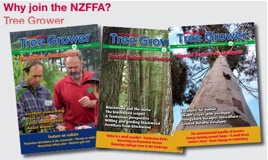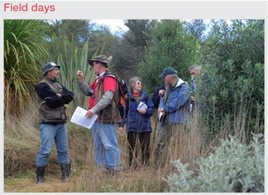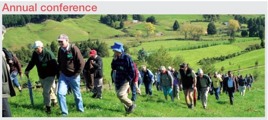Dryland Forests Initiative has funding support for the next few years
Paul Millen, New Zealand Tree Grower August 2010.
If we can ensure a future supply of home grown naturally durable eucalypt hardwood it will also help diversify land use, mitigate climate change and reduce soil erosion. Establishing durable eucalypt forests in New Zealand is a significant opportunity to help improve the sustainability of the rural sector.
The aim of the New Zealand Dryland Forests Initiative (NZDFI) is to advance the research and development of durable eucalypt forests. The main goal is to establish New Zealand as an internationally recognised world leader in the breeding of durable eucalypts and the production of high quality hardwoods.
We started working toward this in 2003 when we sowed the first seeds of a number of potential species that we planted in trials. Now, seven years later and after many hours spent in preparing applications, we have been successful in obtaining a grant of $399,000 from the Sustainable Farming Fund for the next three years. This grant means that we can expand our tree breeding programme and promote the establishment of genetically improved durable eucalypts in some of the driest regions.
The grant is also matched by significant financial support from others involved who are providing additional cash totalling $320,000. This will be supplemented by an additional $300,000 of ‘in kind’ contributions.
Success from community support
The chairman of the NZDFI, Shaf van Ballekom, believes that central to success of our programme is the wide cross sector involvement with a strong community of interest with a common purpose. He says that there has been rapidly growing interest and support since the NZDFI was formally established in July 2008.
He says that they now have the interest and support of farm foresters and wine growers.The initiative is based at a regional research centre with a national university leading the tree improvement programme. There are five regional councils supporting the project and a number of landowners offering sites for breeding populations.The common objective is to produce naturally durable wood products.
Markets for naturally durable timber
The programme started with the aim of genetically improving species that are suitable for use as untreated hardwood posts in vineyards to replace copper-chromium-arsenic (CCA) treated pine. However there are many other uses for an alternative to treated posts, including kiwifruit, pipfruit and stone fruit trellis as well as fences and farm buildings. We want to support landowners who are keen to grow and mill durable eucalypt timber for their own use. The trees can be planted in farm shelterbelts or woodlots and thinned for fence posts for farm use.
We also want to encourage farm foresters and forest growers to diversify New Zealand’s timber supply by growing high quality durable hardwood. This would be a substitute for the millions of dollars of hardwood imported from unsustainably managed tropical forests. There are a multitude of potential end uses, including cross-arms for power poles, power poles, railway sleepers, building and finishing timbers. There has been a decline in the sustainable supply of durable hardwood that is exported by Australia and international demand for high value tropical hardwood continues unabated.

A land use option for dry lands
Durable eucalypts are a resilient forestry option for dry areas, those with rainfall less than 1000 mm a year. These regions are predicted to expect more frequent prolonged droughts as a result of climate change.
Dry land can sustain productive forest. For example it has been found that Yatir pine forest planted in 1964 in Israel, with an annual rainfall of less than 500 mm, sequesters carbon as rapidly as pine forests in continental Europe.
We anticipate durable eucalypts being able to sequester carbon at higher rates than pine. Their rapid growth rates, combined with their wood being twice as dense age for age as radiata pine, makes them a very eligible as species for MAF’s Afforestation Grants Scheme and Emissions Trading Scheme.
Other values
Durable eucalypt forests will also help combat soil erosion as they have extensive root systems that coppice following felling or after fire. Some species provide nectar and pollen for native birdlife and honey bees. These tree species are well adapted to continuous cover forestry and are likely to have high productivity especially when planted on warm dry sheltered coastal lowlands.
Currently, 90 per cent of New Zealand exotic forests are radiata pine. However, markets for radiata are generally of modest value and the wood qualities of pine will never match durable hardwoods. Eucalypt forests grown in New Zealand account for only one per cent of the annual cut.
Many corporate growers are focused on growing Eucalyptus nitens for low-value chipwood, with E. fastigata becoming a popular carbon species for new planting under the ETS. Both species produce non durable wood and are of lower density than durable species.
Tree breeding strategy
Farm foresters have been planting trials and small blocks of a myriad of durable species for many years. These will produce sawlogs of variable wood quality. The underlying cause of variable wood quality is genetic, and these existing trees are a very narrow genetic resource that limits screening to remove undesirable features.
The main aim of the NZDFI is the establishment of a wide genetic resource for tree improvement. We are collecting thousands of seeds in Australia this winter. These are needed to establish large base breeding populations of up to five selected eucalypts that produce durable timber. The durability has to be either Class 1 or Class 2 in the Australian Standard. The trees also have to show the potential for excellent survival and growth on the dry lands of Gisborne to Canterbury where rainfall annual rainfall is less than 1000 mm.
These breeding populations will let us evaluate variations at an early age of around three or four years. Then we can select the best families and individuals for fast growth, good form and early heartwood formation. Using rapid early screening techniques we plan to have improved germplasm available by 2014. Then we intend to screen for elite timber properties − high durability, intense colour, and with reduced checking and growth stresses.
Each species will be planted at three sites to expose trees to different growing conditions and as an insurance against catastrophes such as fire. All species will be grown in Marlborough with sites selected in other regions that suit each species. These different sites will test the species across a range of environments and provide comparative data for screening individual families.
We have chosen multiple species for a number of reasons −
- Diversification reduces risk
- Individual species are site specific, having evolved in niche environments in Australia and a selection of species is required to cover the diversity of New Zealand sites
- Out-crossing of species will create elite hybrids with the best traits of each species and extend the range of sites able to grow durable eucalypts successfully
- Only scattered natural populations remain in Australia and we will archive and undertake innovative research techniques to genetically improve these species.
Establishing breeding populations
We selected Eucalyptus bosistoana as our first species for tree improvement. This is known in Australia as coastal grey box and produces an excellent Class 1 durable timber. We completed our initial planting of 66 families of E. bosistoana last year.

The programme included planting seedlings and buffer seedlings at three sites −
- Lawson’s site, South Marlborough planting – 4,500 seedlings
- MDC Cravens Road site, South Marlborough planting – 3,750 seedlings
- Martin site, North Canterbury – 3750 seedlings.
A cool wet spring ensured excellent survival and early growth of seedlings at all sites. In March, a survival sample assessment was completed at all sites with survival at the Martin site 100 per cent, the Lawson site 99.5 per cent and the Cravens Road site 96 per cent. The mean top height of the tallest three trees in the sample plots was measured as 101 cm at the Lawson site, 100.5 cm at the Cravens Road site, and 92.1 cm at the Martin site.
More planting
This year we intend to plant another 37 new families of E. bosistoana. These have been propagated from seed collected last year in the Cann River area of Victoria as well as inland sites in central New South Wales. In addition, seedlings from 20 families of E. argopholia will be planted to provide a sub-population for testing hybrids at a later stage of our breeding programme. With our grant, we are planning to establish breeding populations for three additional species in 2011 – a total of up to 60,000 trees at up to nine separate sites.
Currently, Proseed have seed collectors working in eastern Australia to collect from individual families across the natural range of two more durable eucalypts. These are E. globoidea and E. quadrangulata. Seed collection from elite trees of E. globoidea growing in three New Zealand plantations is also planned. In addition, individual tree seedlots are being acquired from Australian eucalypt breeding programmes for E. camaldulensis and E. cladocalyx, with the choice of our third species dependent on what seed is available and affordable.
Additional species trials
We also have plans to test a number of additional durable species that we intend to plant in small demonstration trials in 2011. These trials will evaluate the species for early survival and growth alongside the candidate species.
They may include −
Class 1 durable species
E. longifolia Woolly butt
E. longirostrata Grey gum
E. tricarpa Red ironbark
E. rummeryi Steel box
Class 2 durable species
E. sphaerocarpa Blackdown stringybark
E. notablis Blue mountains mahogany
Class 3 durable species
E. macrorhyncha Red stringybark
E. eugenoides White stringybark
E. blaxandii Blaxland’s stringybark
E. baxterii Brown stringybark
Early wood quality assessment
To develop the techniques for assessing wood quality at an early age, a total of 200 E. bosistoana and 25 E. argophloia seedlings will be grown under glasshouse conditions in Christchurch City Council’s nursery in Harewood. These will be destructively sampled at the School of Forestry in 2012 at two years of age to evaluate the techniques that have been pioneered for evaluating the wood properties of two- year-old pine. These include early measurement of density, growth stress, shrinkage, end checking and early heartwood formation. We intend to begin extensive screening for wood quality in our E. bosistoana breeding populations in 2014.
Regional extension programme
With SFF support we are planning a regional extension programme to promote the planting of new eucalypt woodlots and plantations. This will be in some of New Zealand’s driest regions, including Marlborough, Canterbury, Gisborne, Hawkes Bay and Wairarapa. We want to transfer our knowledge to farm foresters, regional land managers and consultants so that they can successfully establish and manage these genetically improved durable timber species. Support has been promised by the regional councils and local branches of the NZFFA in those regions.
The extension programme includes establishing three demonstration trials. These will be of select eucalypt species along with some of the additional durable species we want to evaluate across a range of sites in Marlborough, Gisborne, Hawkes Bay,Waiarapa and coastal Canterbury. One site in each region is planned for planting this year with two more to be planted in 2011. These demonstration trials will require sites of 0.2 to 0.4 hectares in area and need to be strategically located in different places that offer variation in climate, aspect and altitude, as well as soils and proximity to the coast. They also need to have good all weather access.
In addition, we plan to have at least one of our main breeding populations in each of the participating regions, provided that a suitable site of up to four hectares can be made available. This site needs to be uniform in soils and landform, preferably an easy hill slope that is north, east or west facing with good access. For these sites we would look for, a legal agreement with the landowners for use of the site for a period of a minimum of 10 years. The agreement can be by way of a lease or a forestry rights licence. If you are a land owner living in one of these regions and want to offer a site, please contact us.
Information will be available
We also developing information with the support of Scion to research and collate a series of leaflets. These will summarise current information for durable species and potential management options they offer growers for post, pole and timber production, carbon sequestration, soil conservation and native biodiversity.
Information on site selection and preparation, planting and early maintenance for maximum survival and growth with known pests and diseases will also be included. These will be published on line by December 2011. They will also be promoted at five regional workshops and field visits to demonstration trials and breeding populations that are planned for January 2012 to May 2013. Workshops will be planned and co ordinated with the local branches of the NZFFA and supported by local MAF and regional council staff.
Main project members are Shaf van Ballekom CEO of Proseed, Paul Millen (NZFDI Project Manager) a Marlborough consultant, Luis Apiolaza a senior lecturer in tree genetics at the School of Forestry, Ruth McConnochie a eucalypt research specialist, Shakti Chauhan and John Walker experts in testing and evaluating young timber at the School of Forestry and Ian Nicholas, well known for specialist hardwood research and extension work.

 Farm Forestry New Zealand
Farm Forestry New Zealand

